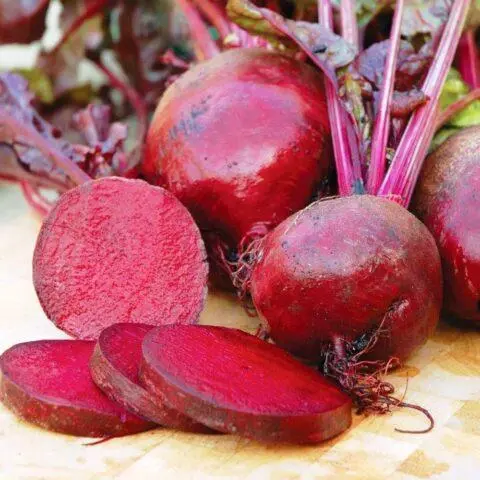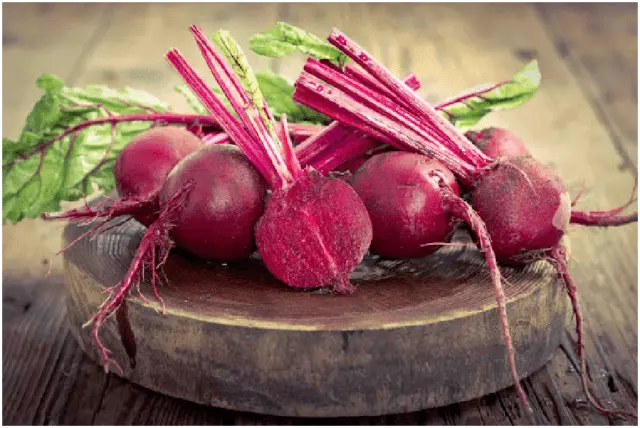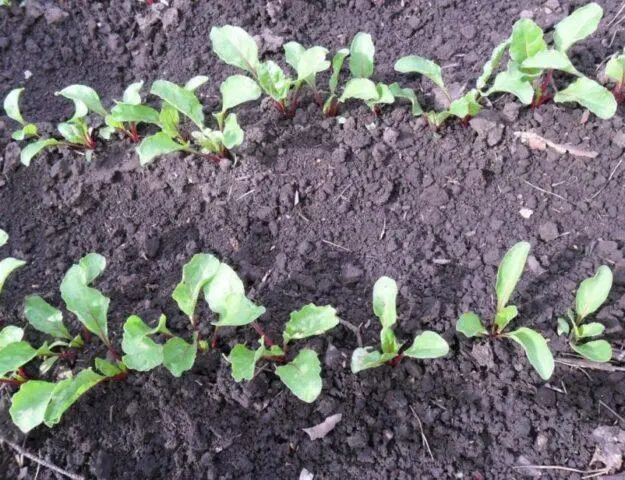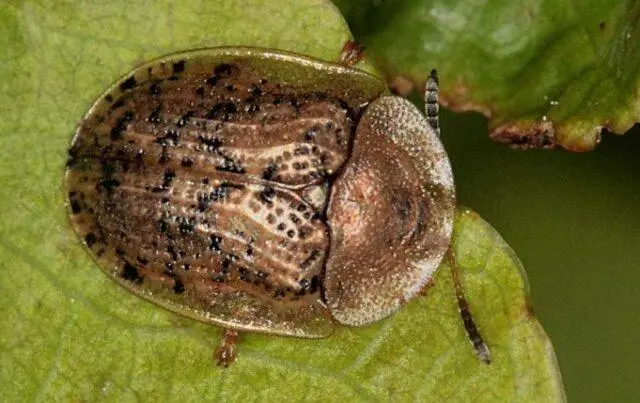Contents
- History of origin
- Description of the Bordeaux beet variety
- Characteristics of Bordeaux beets
- Features and description of beetroot varieties Bordeaux 237
- Advantages and disadvantages
- Planting Bordeaux beets
- Bordeaux beet care
- Possible diseases and pests
- Conclusion
- Reviews of gardeners about beets Bordeaux and Bordeaux 237
Bordeaux beet is a popular variety that has been known for over 50 years. It has good resistance to drought, frost and pests. The culture is grown in almost all regions. The taste is excellent, and the yield reaches 8 kg per square meter.
History of origin
Bordeaux beets were bred on the basis of VIR named after V.I. N.I. Vavilov. The variety was obtained by a team of breeders (Burenin V.I., Pivovarov V.F., Piskunova T.M. and others). The Bordeaux 237 was taken as the basis, bred in 1937 and entered into the register in 1943.
Variety Bordeaux has been successfully tested. It was included in the register of breeding achievements of the Federation in 2003. Approved for cultivation in most regions:
- middle lane;
- the Volga region;
- southern regions;
- Eastern Siberia;
- Far East.
It is also cultivated in neighboring countries – Ukraine, Belarus, Moldova. It is not a hybrid, so Bordeaux beets can be grown both from purchased seeds and from seed collected independently.
Description of the Bordeaux beet variety
The culture produces a semi-erect rosette with green petioles. The leaves are oval, with or without wavy edges, green, the surface is slightly bubbly. Petioles are green. Bordeaux beets are single-seeded, i.e. gives only one sprout, which makes it easier to grow.
Root crops are rounded, with very little or no head cork, red flesh. By weight, they reach 200–350 g. The taste is characterized as excellent. Can be used fresh for cooking various dishes. During heat treatment, the pulp does not lose color.
The composition includes water (81%), dry matter (19%), sugar (12–13%).
Characteristics of Bordeaux beets
Bordeaux beets are productive varieties. From 1 m², you can collect from 4 to 8 kg, depending on the type of soil, the climatic conditions of the region and the features of care. In industrial cultivation, the indicator ranges from 300 to 530 c/ha (in the conditions of the middle zone) or 315–460 c/ha (in the conditions of Western Siberia). The maximum indicator was registered in the Tula region (more than 630 c/ha).

Bordeaux beet roots are large, rounded
This is a mid-season variety: technical maturity occurs 85–95 days after planting. The keeping quality of fruits under the storage conditions (dark place, temperature 2-5 degrees Celsius, moderate humidity) is good. Root crops are transportable – they can be transported over long distances to the place of sale, storage or processing.
The Bordeaux variety is resistant to frost, so winter sowing is allowed in October. It also tolerates drought well – it can be grown in regions with insufficient moisture.
Features and description of beetroot varieties Bordeaux 237
The first in the series is the Bordeaux 237 variety, obtained in 1937. It is approved for cultivation in all regions of the country. Beets are similar in appearance and taste. Rosettes of leaves are semi-erect. At the same time, the petioles are not pure green – their underside is red. The leaves are oval, typical green in color, the surface is medium bubbly, a slight waviness is noticeable along the edges.
Bordeaux 237 beet roots are medium and large, rounded. By weight, on average, from 230 to 510 g. The flesh is dark red, the taste is good and rich. The composition includes water (81%) and dry matter (19%), including sugar (total content up to 14%).
The yield of the Bordeaux 237 beet variety averages from 360 to 453 c/ha, which corresponds to 4–8 kg per 1 m2. The maximum indicator of 797 c/ha was registered in the Kursk region. Marketable products have a yield of 94% to 98%, so the variety is grown both in private and on farms.
Advantages and disadvantages
Bordeaux beets are popular among summer residents and farmers, as the variety is well adapted to the climatic conditions of different regions. It does not require special care, the root crops ripen quickly enough, and the yield is consistently high.

Bordeaux beet pulp does not lose its rich color even when heated
Pros:
- high yield;
- excellent taste;
- attractive appearance;
- frost resistance;
- single seed;
- good keeping quality and transportability;
- undemanding to care;
- resistance to frost and drought;
- winter sowing is possible;
- germination almost 100%.
Cons:
- requires a large area for cultivation;
- an unplanned dive is necessary due to the high percentage of germination.
Planting Bordeaux beets
This variety can be grown by direct sowing in the ground and by seedlings (to accelerate maturation). The timing of sowing depends on the method of agricultural technology and the climatic conditions of the region:
- In spring, seeds are sown in open ground when the soil warms up to at least 9 degrees.
- In autumn, winter sowing is planned for the second half of October, 2-3 weeks before frost.
- For seedlings, seeds are sown a month before transplanting into the ground, i.e. no later than the beginning of April.
Growing seedlings
Before planting seeds for seedlings, they must be selected and prepared:
- Place in a glass of salted water and discard any that float up after a few minutes.
- Put on gauze and soak with warm water, holding at room temperature until swelling.
- Place damp cheesecloth in saucers and refrigerate for 5-7 days.
Bordeaux beet seeds can be planted both in common boxes and in separate containers (2-3 each) to avoid picking. The soil is purchased in a store or pre-compiled on the basis of garden soil, humus, peat and sand (2: 1: 1: 1).
The instructions for growing seedlings are simple:
- Deepen the seeds by 1–1,5 cm, moisten the soil surface.
- Cover with foil with holes. Put in a warm place.
- Remove the film after emergence.
- Transfer the container to a room with a temperature of 14-15 degrees.
- A week before transplanting, harden the seedlings on the balcony.

Landing in open ground
Before planting seeds in open ground, the site is dug up and fertilized with humus or compost (5 kg per 1 m2). The place must be chosen open, the soil must be loose and not acidified (pH about 7,0). It is unacceptable to grow Bordeaux beets or other varieties in one place for more than four years in a row.
Landing pattern is standard:
- furrows 3 cm deep;
- row spacing – 30 cm;
- the distance between adjacent seeds is 8 cm.
Immediately after planting, the furrows must be carefully watered so as not to wash the surface layer.
Bordeaux beet care
Caring for this variety is quite simple. Watering should be moderate – once a week is enough, but more often in drought so that the top layer does not dry out completely. 2-3 weeks before harvest, water is no longer given. After heavy rain or watering, the soil needs to be loosened. Weeding is carried out as necessary.
Top dressing is applied three times per season:
- At the stage of leaf formation – complex fertilizer.
- At the beginning of fruiting – double superphosphate and potassium sulfate (40 g per 1 m2).
- After 3-4 weeks, complex fertilizer is added again.
Possible diseases and pests
Beetroot varieties Bordeaux and Bordeaux 237, with proper care, are rarely affected by diseases and pests. But in some cases (for example, against the background of excessive watering, crop rotation disturbances), the crop may suffer from fungal infections:
- cercosporosis – the disease develops against the background of excessive soil moisture;
- pernosporosis (downy mildew) – a whitish coating appears on the leaves. To prevent it, you need to disinfect the seeds and soil on the eve of planting.
Of the insects, sugar beet flies, flea beetles and shield beetles are dangerous. You can fight them with folk remedies, for example, a solution of mustard powder, an infusion of chili peppers, onion peels, and a decoction of marigolds. In extreme cases, planting Bordeaux beets is treated with insecticides:
- “Alatar”;
- “Fufanon”;
- “Spark double effect”.

Beet shield and other pests can be fought with folk remedies and insecticides
Conclusion
Bordeaux beet is one of the most unpretentious and productive varieties. Suitable for growing outdoors in most regions. Root crops are transportable and keeping, which allows you to stock up until spring.









